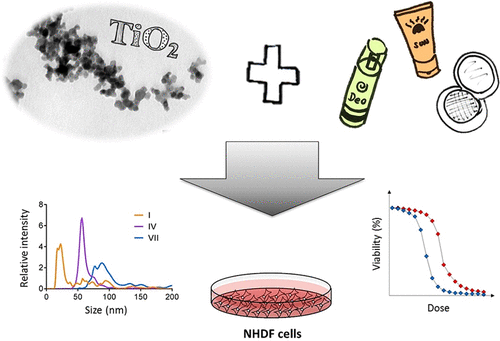当前位置:
X-MOL 学术
›
Chem. Res. Toxicol.
›
论文详情
Our official English website, www.x-mol.net, welcomes your
feedback! (Note: you will need to create a separate account there.)
Interactions of TiO2 Nanoparticles with Ingredients from Modern Lifestyle Products and Their Effects on Human Skin Cells.
Chemical Research in Toxicology ( IF 3.7 ) Pub Date : 2020-03-05 , DOI: 10.1021/acs.chemrestox.9b00428 Mark Geppert 1 , Alexandra Schwarz 1 , Lea Maria Stangassinger 1 , Susanna Wenger 1 , Lisa Maria Wienerroither 1 , Stefanie Ess 1 , Albert Duschl 1 , Martin Himly 1
Chemical Research in Toxicology ( IF 3.7 ) Pub Date : 2020-03-05 , DOI: 10.1021/acs.chemrestox.9b00428 Mark Geppert 1 , Alexandra Schwarz 1 , Lea Maria Stangassinger 1 , Susanna Wenger 1 , Lisa Maria Wienerroither 1 , Stefanie Ess 1 , Albert Duschl 1 , Martin Himly 1
Affiliation

|
The number of consumer products containing nanoparticles (NPs) experienced a rapid increase during the past decades. However, most studies of nanosafety have been conducted using only pure NPs produced in the laboratory, while the interactions with other ingredients in consumer products have rarely been considered so far. In the present study, we investigated such interactions-with a special focus on modern lifestyle products (MLPs) used by adolescents. An extensive survey was undertaken at different high schools all over Austria to identify MLPs that either contain NPs or that could come easily in contact with NPs from other consumer products (such as TiO2 from sunscreens). Based on the results from a survey among secondary schools students, we focused on ingredients from Henna tattoos (2-hydroxy-1,4-naphtoquinone, HNQ, and p-phenylenediamine, PPD), fragrances (butylphenyl methylpropional, known as Lilial), cosmetics and skin-care products (four different parabens). As a cellular model, we decided to use neonatal normal human dermal fibroblasts (nNHDF), since skin contact is the main route of exposure for these compounds. TiO2 NPs interacted with these compounds as evidenced by alterations in their hydrodynamic diameter observed by nanoparticle tracking analysis. Combinations of TiO2 NPs with the different MLP components did not show altered cytotoxicity profiles compared to MLP components without TiO2 NPs. Nevertheless, altered cellular glutathione contents were detected after incubation of the cells with Lilial. This effect was independent of the presence of TiO2 NPs. Testing mixtures of NPs with other compounds from consumer products is an important approach to achieve a more reliable safety assessment.
中文翻译:

TiO2纳米粒子与现代生活方式产品成分的相互作用及其对人体皮肤细胞的影响。
在过去的几十年中,包含纳米颗粒(NPs)的消费产品数量迅速增加。但是,大多数纳米安全性研究仅使用实验室中生产的纯NP进行,而到目前为止,很少考虑与消费品中其他成分的相互作用。在本研究中,我们调查了这种相互作用-特别关注青少年使用的现代生活方式产品(MLP)。在奥地利各地的不同高中进行了广泛的调查,以确定含有NP或很容易与其他消费产品(例如防晒霜中的TiO2)的NP接触的MLP。根据对中学生的一项调查结果,我们重点研究了指甲花纹身的成分(2-羟基-1,4-萘醌,HNQ和对苯二胺,PPD),香料(丁基苯基甲基丙酸,称为Lilial),化妆品和皮肤护理产品(四种对羟基苯甲酸酯)。作为细胞模型,我们决定使用新生儿正常的人类真皮成纤维细胞(nNHDF),因为皮肤接触是这些化合物暴露的主要途径。TiO2 NPs与这些化合物发生相互作用,这是通过纳米颗粒跟踪分析观察到的其流体动力学直径变化来证明的。与不具有TiO2 NP的MLP组件相比,具有不同MLP组分的TiO2 NP的组合没有显示出改变的细胞毒性谱。然而,将细胞与Lialal孵育后,发现细胞中的谷胱甘肽含量发生了变化。这种作用与TiO2 NP的存在无关。
更新日期:2020-02-24
中文翻译:

TiO2纳米粒子与现代生活方式产品成分的相互作用及其对人体皮肤细胞的影响。
在过去的几十年中,包含纳米颗粒(NPs)的消费产品数量迅速增加。但是,大多数纳米安全性研究仅使用实验室中生产的纯NP进行,而到目前为止,很少考虑与消费品中其他成分的相互作用。在本研究中,我们调查了这种相互作用-特别关注青少年使用的现代生活方式产品(MLP)。在奥地利各地的不同高中进行了广泛的调查,以确定含有NP或很容易与其他消费产品(例如防晒霜中的TiO2)的NP接触的MLP。根据对中学生的一项调查结果,我们重点研究了指甲花纹身的成分(2-羟基-1,4-萘醌,HNQ和对苯二胺,PPD),香料(丁基苯基甲基丙酸,称为Lilial),化妆品和皮肤护理产品(四种对羟基苯甲酸酯)。作为细胞模型,我们决定使用新生儿正常的人类真皮成纤维细胞(nNHDF),因为皮肤接触是这些化合物暴露的主要途径。TiO2 NPs与这些化合物发生相互作用,这是通过纳米颗粒跟踪分析观察到的其流体动力学直径变化来证明的。与不具有TiO2 NP的MLP组件相比,具有不同MLP组分的TiO2 NP的组合没有显示出改变的细胞毒性谱。然而,将细胞与Lialal孵育后,发现细胞中的谷胱甘肽含量发生了变化。这种作用与TiO2 NP的存在无关。











































 京公网安备 11010802027423号
京公网安备 11010802027423号